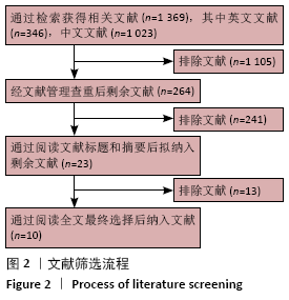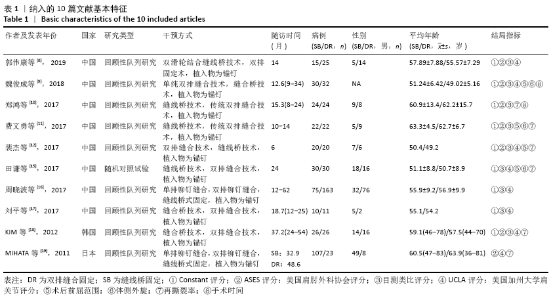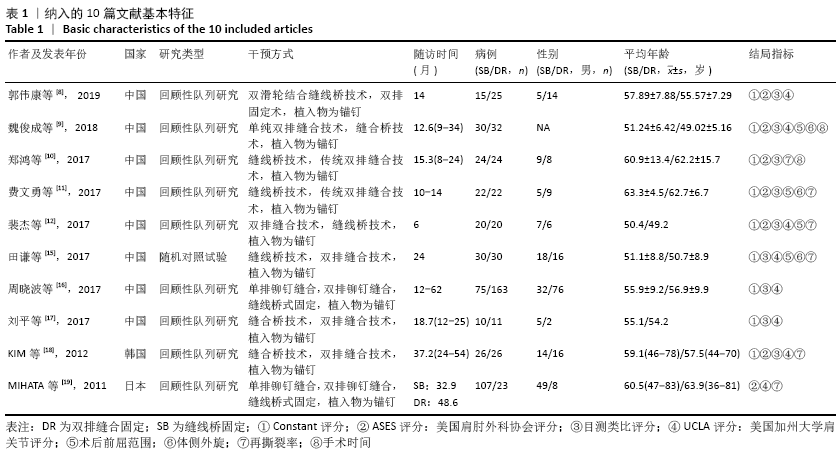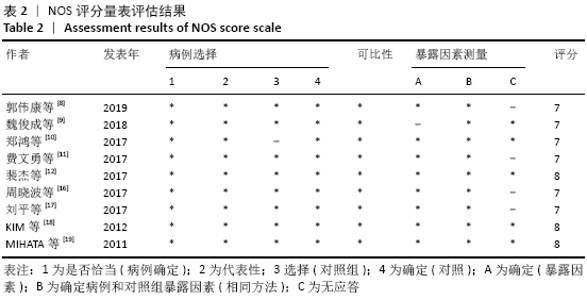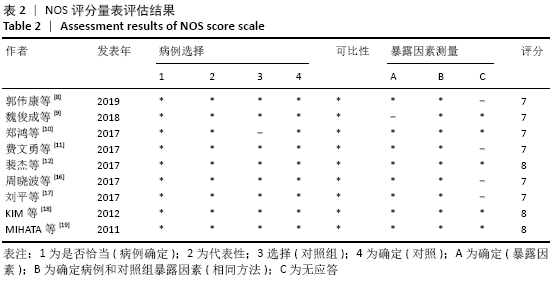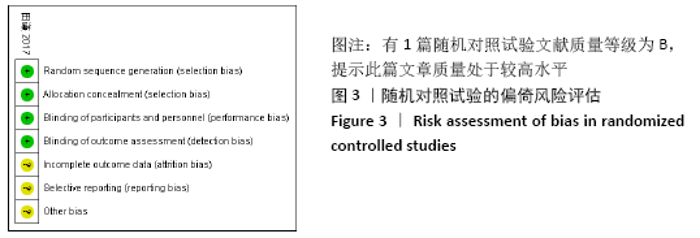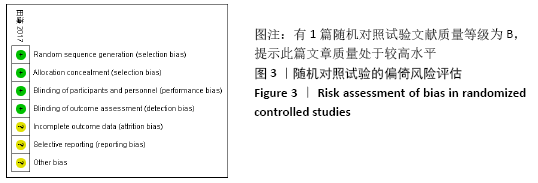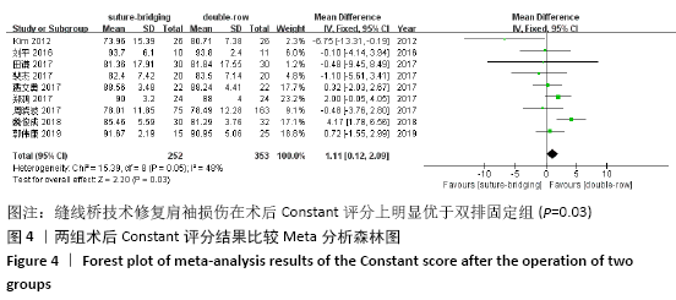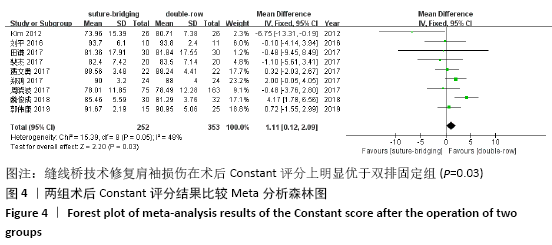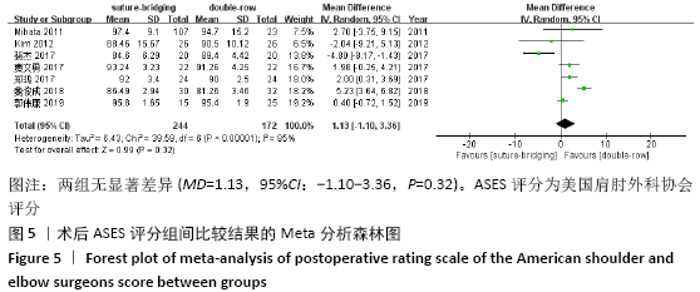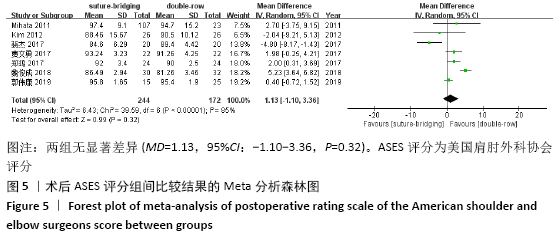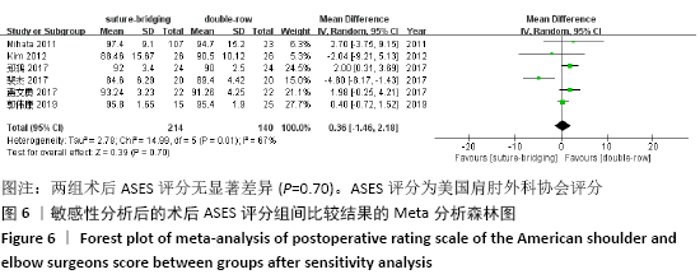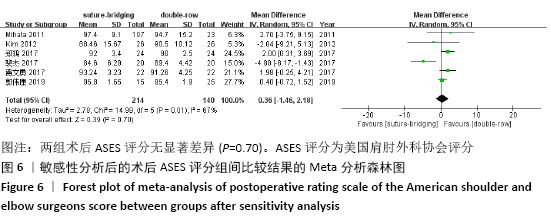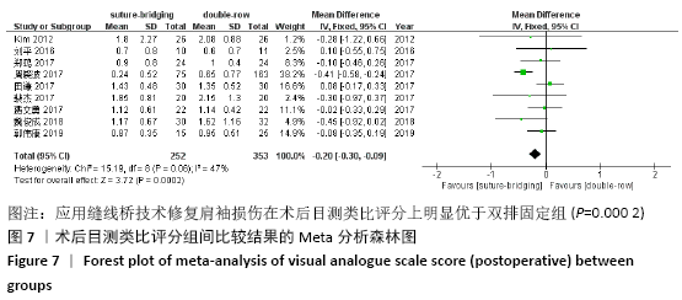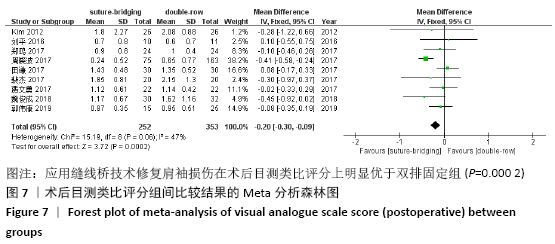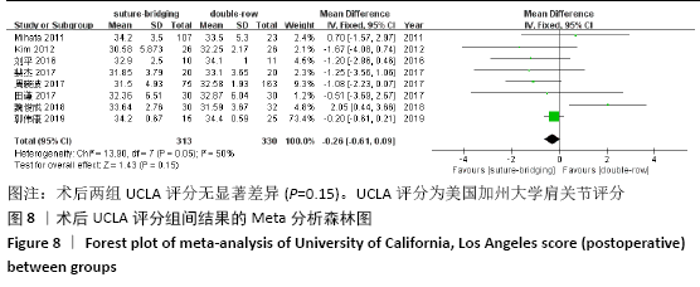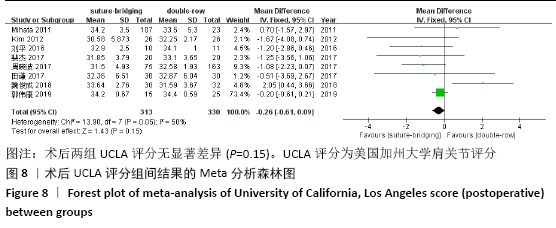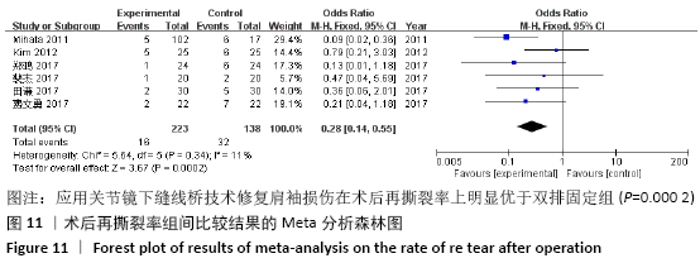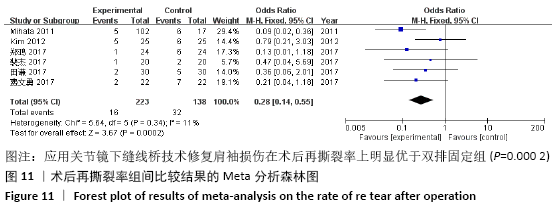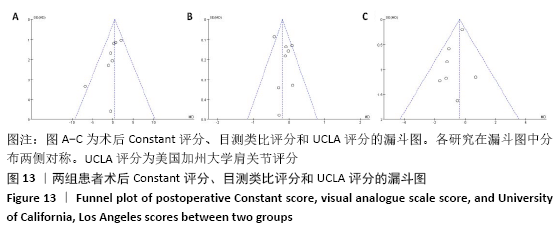Chinese Journal of Tissue Engineering Research ›› 2021, Vol. 25 ›› Issue (21): 3431-3437.doi: 10.3969/j.issn.2095-4344.3872
Previous Articles Next Articles
Comparison of the effects of arthroscopic double-row suture fixation and suture bridge fixation for rotator cuff injury: a meta-analysis
Jiang Lingkai, Wei Lei, Dong Zhengquan, Gu Xiaodong, Li Pengcui
- Laboratory of Orthopedics, Second Hospital of Shanxi Medical University, Taiyuan 030000, Shanxi Province, China
-
Received:2020-09-23Revised:2020-09-25Accepted:2020-10-30Online:2021-07-28Published:2021-01-25 -
Contact:Li Pengcui, MD, Chief physician, Laboratory of Orthopedics, Second Hospital of Shanxi Medical University, Taiyuan 030000, Shanxi Province, China -
About author:Jiang Lingkai, Master candidate, Laboratory of Orthopedics, Second Hospital of Shanxi Medical University, Taiyuan 030000, Shanxi Province, China -
Supported by:the National Natural Science Foundation of China, No. 81772415 (to WL)
CLC Number:
Cite this article
Jiang Lingkai, Wei Lei, Dong Zhengquan, Gu Xiaodong, Li Pengcui. Comparison of the effects of arthroscopic double-row suture fixation and suture bridge fixation for rotator cuff injury: a meta-analysis [J]. Chinese Journal of Tissue Engineering Research, 2021, 25(21): 3431-3437.
share this article
| [1] 高绪仁,朱梁,陈永吉,等.关节镜下Suture Bridge双排法和SCOI单排法缝合修复中型肩袖撕裂的疗效比较[J].中国矫形外科杂志,2018,26(22):2107-2110. [2] SCHMIDT CC, JARRETT CD, BROWN BT. Management of rotator cuff tears. J Hand Surg. 2015;40:399-408. [3] BEDEIR YH, SCHUMAIER AP, ABU-SHEASHA G, et al. Type 2 retear after arthroscopic single-row, double-row and suture bridge rotator cuff repair: a systematic review. Eur J Orthop Surg Traumatol. 2019;29(2): 373-382. [4] 许挺,何利雷,王昌兵.肩关节镜下缝线桥技术治疗中度肩袖撕裂的临床疗效观察[J].中国医药科学,2018,8(11):28-31, 51. [5] 史晓鹏,汪志芳.肩关节镜下单滑轮缝线桥技术治疗中小型及部分肩袖损伤疗效观察[J].新疆医学,2017,47(7):717-720. [6] 肖展豪,陈强,向宁.肩袖损伤经肩关节镜下双排缝线 桥技术治疗 128 例分析[J].中国卫生标准管理,2016,7(11):45-46. [7] HASHIGUCHI H, IWASHITA S, SONOKI K, et al. Clinical outcomes and structural integrity of arthroscopic double-row versus suture-bridge repair for rotator cuff tears. J Orthop. 2018;15(2):396-400. [8] 郭伟康,赖兵,黄健,等.双滑轮结合缝线桥技术和双排固定术治疗肩袖全层撕裂的疗效对比[J].实用骨科杂志,2019, 25(8):676-680. [9] 魏俊成,颜世昌,彭俊洋,等.关节镜下单纯双排缝合与缝合桥技术修复肩袖损伤的临床观察[J].中国医师进修杂志, 2018,41(9):833-836. [10] 郑鸿,赵甲军,谭宏昌,等.关节镜下缝线桥与传统双排技术修复全层肩袖撕裂的比较[J].中华创伤骨科杂志,2017, 19(9):806-809. [11 费文勇,袁即山,真启云,等.关节镜下缝线桥技术与双排技术修复全层中撕裂肩袖损伤的疗效比较[J].临床骨科杂志, 2017,20(2):157-160, 164. [12] 裴杰,王青.肩袖撕裂双排缝合技术与缝线桥技术的疗效对比分析[J].中国运动医学杂志,2017,36(1):9-13, 20. [13] 赵颖,杨园园,杜雅薇,等.黄连素治疗血脂异常有效性和安全性随机对照临床试验的系统评价与Meta分析[J].中国中药杂志,2020,45(3):664-673. [14] 贾赫尘,王韬,焦力群,等.成人症状性烟雾病旁路移植手术治疗患者远期预后的Meta分析[J].中国脑血管病杂志, 2020,17(8):436-445. [15] 田谦.关节镜下缝线桥与双排锚钉修复肩袖撕裂的疗效观察[J].现代仪器与医疗,2017,23(2):113-115. [16] 周晓波,梁军波,陈忠义.关节镜下3种方式修补肩袖损伤的疗效分析[J].中国骨伤,2017,30(8):689-694. [17] 刘平,敖英芳.关节镜下缝合桥技术与双排缝合技术治疗肩袖部分损伤21例回顾性研究[J].中国运动医学杂志,2016, 35(2):137-140. [18] KIM KC, SHIN HD, LEE WY, et al. Repair integrity and functional outcome after arthroscopic rotator cuff repair: double-row versus suture-bridge technique. Am J Sports Med. 2012;40(2):294-299. [19] MIHATA T, WATANABE C, FUKUNISHI K, et al. Functional and structural outcomes of single-row versus double-row versus combined double-row and suture-bridge repair for rotator cuff tears. Am J Sports Med. 2011;39(10):2091-2098. [20] TAN M, LAM PH, LE BT, et al. Trauma versus no trauma: an analysis of the effect of tear mechanism on tendon healing in 1300 consecutive patients after arthroscopic rotator cuff repair. Shoulder Elbow Surg. 2016;25(4):12-21. [21] PARK JY, LEE SY, CHUNG SW, et al. Clinical comparison between double-row and transosseous-equivalent repairs for medium to large size rotator cuff tears. Arch Orthop Trauma Surg. 2013;133(12):1727-1734. [22] 毛俊超.关节镜下应用单排和缝合桥技术修复肩袖撕裂的疗效研究[D].唐山:华北理工大学,2015. [23] 张敏健,杨超,罗浩,等.肩袖损伤的治疗方法研究与进展[J].国际外科学杂志, 2018,45(7):487-493. [24] HOLSCHEN M, BRAND F, AGNESKIRCHNER JD. Subacromial spacer implantation for massive rotator cuff tears: clinical outcome of arthroscopically treated patients. Obere Extrem. 2017;12(1):38-45. [25] HERNIGOU P, FLOUZAT LACHANIETTE CH, DELAMBRE J, et al. Biologic augmentation of rotator cuff repair with mesenchymal stem cells during arthroscopy improves healing and prevents further tears: a case-controlled study. Int Orthop. 2014;38(9):1811-1818. [26] BOYER P, BOUTHORS C, DELCOURT T, et al. Arthroscopic double-row cuff repair with suture-bridging: a structural and functional comparison of two techniques. Knee Surg Sports Traumatol Arthrosc. 2015;23(2): 478-486. [27] 刘玉雷,闫辉,肖健.关节镜下缝合桥双排固定技术治疗肩袖全层撕裂的初步疗效[J].中华关节外科杂志(电子版), 2011,5(6):710-714. [28] FERMONT AJ, WOLTERBEEK N, WESSEL RN, et al. Prognostic factors for successful recovery after arthroscopic rotator cuff repair: a systematic literature review. J Orthop Sports Phys Ther. 2014;44(3): 153-163. [29] KIM HM, CALDWELL JM, BUZA JA, et al. Factors affecting satisfaction and shoulder function in patients with a recurrent rotator cuff tear. J Bone Joint Surg Am. 2014;96(2): 106-112. [30] 潘界恩,陈刚,黄成龙.改良压配式双排缝合技术与传统单双排缝合技术在肩袖大型撕裂修补中的生物力学比较[J].中华实验外科杂志,2016,33(11):2601. [31] 潘界恩,陈刚,蔡震海,等.关节镜下两种双排缝合技术治疗肩袖大型撕裂的中期疗效比较[J].中国内镜杂志,2020, 26(4):29-34. [32] 滕清华.三种关节镜下肩袖修复技术的临床疗效对比:网状Meta分析和系统评价[D].南昌:南昌大学,2018. |
| [1] | Xu Feng, Kang Hui, Wei Tanjun, Xi Jintao. Biomechanical analysis of different fixation methods of pedicle screws for thoracolumbar fracture [J]. Chinese Journal of Tissue Engineering Research, 2021, 25(9): 1313-1317. |
| [2] | Jiang Yong, Luo Yi, Ding Yongli, Zhou Yong, Min Li, Tang Fan, Zhang Wenli, Duan Hong, Tu Chongqi. Von Mises stress on the influence of pelvic stability by precise sacral resection and clinical validation [J]. Chinese Journal of Tissue Engineering Research, 2021, 25(9): 1318-1323. |
| [3] | Zhang Tongtong, Wang Zhonghua, Wen Jie, Song Yuxin, Liu Lin. Application of three-dimensional printing model in surgical resection and reconstruction of cervical tumor [J]. Chinese Journal of Tissue Engineering Research, 2021, 25(9): 1335-1339. |
| [4] | Zhang Yu, Tian Shaoqi, Zeng Guobo, Hu Chuan. Risk factors for myocardial infarction following primary total joint arthroplasty [J]. Chinese Journal of Tissue Engineering Research, 2021, 25(9): 1340-1345. |
| [5] | Wei Wei, Li Jian, Huang Linhai, Lan Mindong, Lu Xianwei, Huang Shaodong. Factors affecting fall fear in the first movement of elderly patients after total knee or hip arthroplasty [J]. Chinese Journal of Tissue Engineering Research, 2021, 25(9): 1351-1355. |
| [6] | Wang Jinjun, Deng Zengfa, Liu Kang, He Zhiyong, Yu Xinping, Liang Jianji, Li Chen, Guo Zhouyang. Hemostatic effect and safety of intravenous drip of tranexamic acid combined with topical application of cocktail containing tranexamic acid in total knee arthroplasty [J]. Chinese Journal of Tissue Engineering Research, 2021, 25(9): 1356-1361. |
| [7] | Xiao Guoqing, Liu Xuanze, Yan Yuhao, Zhong Xihong. Influencing factors of knee flexion limitation after total knee arthroplasty with posterior stabilized prostheses [J]. Chinese Journal of Tissue Engineering Research, 2021, 25(9): 1362-1367. |
| [8] | Huang Zexiao, Yang Mei, Lin Shiwei, He Heyu. Correlation between the level of serum n-3 polyunsaturated fatty acids and quadriceps weakness in the early stage after total knee arthroplasty [J]. Chinese Journal of Tissue Engineering Research, 2021, 25(9): 1375-1380. |
| [9] | Zhang Chong, Liu Zhiang, Yao Shuaihui, Gao Junsheng, Jiang Yan, Zhang Lu. Safety and effectiveness of topical application of tranexamic acid to reduce drainage of elderly femoral neck fractures after total hip arthroplasty [J]. Chinese Journal of Tissue Engineering Research, 2021, 25(9): 1381-1386. |
| [10] | Wang Haiying, Lü Bing, Li Hui, Wang Shunyi. Posterior lumbar interbody fusion for degenerative lumbar spondylolisthesis: prediction of functional prognosis of patients based on spinopelvic parameters [J]. Chinese Journal of Tissue Engineering Research, 2021, 25(9): 1393-1397. |
| [11] | Lü Zhen, Bai Jinzhu. A prospective study on the application of staged lumbar motion chain rehabilitation based on McKenzie’s technique after lumbar percutaneous transforaminal endoscopic discectomy [J]. Chinese Journal of Tissue Engineering Research, 2021, 25(9): 1398-1403. |
| [12] | Chen Xinmin, Li Wenbiao, Xiong Kaikai, Xiong Xiaoyan, Zheng Liqin, Li Musheng, Zheng Yongze, Lin Ziling. Type A3.3 femoral intertrochanteric fracture with augmented proximal femoral nail anti-rotation in the elderly: finite element analysis of the optimal amount of bone cement [J]. Chinese Journal of Tissue Engineering Research, 2021, 25(9): 1404-1409. |
| [13] | Du Xiupeng, Yang Zhaohui. Effect of degree of initial deformity of impacted femoral neck fractures under 65 years of age on femoral neck shortening [J]. Chinese Journal of Tissue Engineering Research, 2021, 25(9): 1410-1416. |
| [14] | Zhang Shangpu, Ju Xiaodong, Song Hengyi, Dong Zhi, Wang Chen, Sun Guodong. Arthroscopic suture bridge technique with suture anchor in the treatment of acromioclavicular dislocation [J]. Chinese Journal of Tissue Engineering Research, 2021, 25(9): 1417-1422. |
| [15] | Liang Yan, Zhao Yongfei, Xu Shuai, Zhu Zhenqi, Wang Kaifeng, Liu Haiying, Mao Keya. Imaging evaluation of short-segment fixation and fusion for degenerative lumbar scoliosis assisted by highly selective nerve root block [J]. Chinese Journal of Tissue Engineering Research, 2021, 25(9): 1423-1427. |
| Viewed | ||||||
|
Full text |
|
|||||
|
Abstract |
|
|||||
